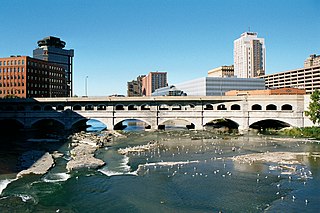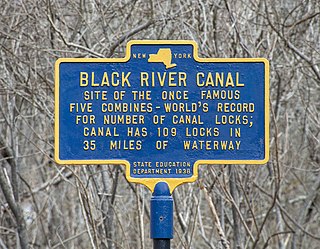
Canastota is a village located inside the Town of Lenox in Madison County, New York, United States. The population was 4,804 at the 2010 census.

Saint Georges is an unincorporated community and former municipality situated on the Chesapeake and Delaware Canal in New Castle County, Delaware, about midway between the Delaware River and Chesapeake Bay.

The Old Erie Canal State Historic Park encompasses a 36-mile (58 km) linear segment of the original Erie Canal's Long Level section. It extends westward from Butternut Creek in the town of DeWitt, just east of Syracuse, to the outskirts of Rome, New York. The park includes restored segments of the canal's waterway and towpath which were in active use between 1825 and 1917. It is part of the New York State Park system.

Sackets Harbor Battlefield State Historic Site is a historically important location in Jefferson County, New York, United States. The historic site is south of the Village of Sackets Harbor, bordering Lake Ontario in the Town of Hounsfield. Two battles were fought near this location during the War of 1812. Some 3,000 men worked at the shipyard building warships, and the village was fortified and garrisoned with thousands of troops.

The Huguenot Schoolhouse, also known as District Schoolhouse No. 3, the 1863 Schoolhouse and the Town of Deerpark Museum, is located on South Grange Road a short distance from US 209 in Huguenot, a hamlet of the Town of Deerpark in Orange County, New York, United States. It was built in 1863, and is a large, one-story, Greek Revival style masonry building. It closed as a school in 1961, and currently serves as a local historic museum.

The Hyde Park Firehouse is located along U.S. Route 9 in Hyde Park, New York. It was built in 1902 as the headquarters for the Eagle Engine and Rescue fire company, which later became part of the Hyde Park Fire Department and moved to newer quarters a block further up Route 9. Architects John O'Donnell and William J. Beardsley designed the building in a Renaissance Revival architectural style. It was added to the National Register of Historic Places in 1993.

Lockport Industrial District is a national historic district located at Lockport in Niagara County, New York. The district features the two sets of Erie Canal locks constructed in 1859 and in 1909–1918, respectively known as the Northern Tier and Southern Tier. Also in the district are the remains of industrial buildings built along the related hydraulic raceway along the north side of the canal.

Buffalo North Breakwater South End Light is a lighthouse formerly located at the entrance to Buffalo Harbor, Buffalo, New York. It is one of two "bottle shaped" beacons located in Buffalo Harbor; the other is the South Buffalo North Side Light. It is a 29-foot (8.8 m) high beacon constructed of boiler plate. It measures 10 feet 3⁄4 inch (3.067 m) at the bottom and 2 feet 3 inches (0.69 m) at the top. It is distinguished by four cast iron port windows and a curved iron door. It was first lit on September 1, 1903, and originally equipped with a 6th-order Fresnel lens. A battery operated 12 volt lamp with a 12 inches (300 mm) green plastic lens was installed in the beacon c. 1960, when a domed roof formerly mounted over the lens was removed. The beacon was removed in 1985, and now stands on the grounds of the Buffalo (main) Light. Its twin is located at the Dunkirk Lighthouse and Veterans Park Museum.

Erie Canal: Second Genesee Aqueduct, also known as the Broad Street Aqueduct or Broad Street Bridge, is a historic stone aqueduct located at Rochester in Monroe County, New York. It was constructed in 1836–1842 and originally carried the Erie Canal over the Genesee River. The overall length of the aqueduct including the wings and abutments is 800 feet (240 m). The aqueduct is 70 feet (21 m) wide and has massive parapets on either side. It is one of four major aqueducts in the mid-19th century Erie Canal system. In 1927, a roadbed was added to carry automobile traffic and named Broad Street. It also carried a part of the Rochester Subway.

Crooked Lake Outlet Historic District is a national historic district located near Penn Yan in Yates County, New York. The district is located along a seven-mile recreational trail that parallels the Keuka Lake Outlet. The district includes several mill sites along the gorge. It also includes nine areas that contain surface and subsurface archaeological remains.

Martisco station, also known as Martisco Station Railway Museum, is a railroad station in Martisco, Onondaga County, New York. It was built in 1870 by the Auburn and Syracuse Railroad, and is a two-story, Italianate style brick building. Decorative brackets support an unusually long overhang of the roof. The line and station were eventually acquired by the New York Central Railroad. The station is owned by the Central New York Chapter of the National Railway Historical Society, and is open as a museum during limited hours in the summer. Adjacent to the station is a contributing Pennsylvania Railroad dining car.

Canastota Methodist Church, now known as Greystone Community Center, or Greystone Castle, is a historic Methodist church at Main and New Boston streets in Canastota in Madison County, New York. It was built in 1909 and is a large, asymmetrical building built of Pennsylvania white marble. It reflects the influence of the Richardsonian Romanesque style in its heavy, horizontal massing, wrought-hewn masonry construction and broad, round arch door and window openings. A tower has a crenellated turret at the top.

US Post Office-Boonville is a historic post office building located at Boonville in Oneida County, New York, United States. It was designed and built in 1937, and is one of a number of post offices in New York State designed by the Office of the Supervising Architect of the Treasury Department, Louis A. Simon. It is a one-story, five bay building with a poured concrete foundation and brick facades in the Colonial Revival style. It features a hipped roof surmounted by an octagonal cupola with metal window tracery and an iron weathervane. The interior features a mural painted by the McCullough sisters of New York City depicting a 19th-century scene on the Black River Canal. It is a contributing structure within the Boonville Historic District.

Five Lock Combine and Locks 37 and 38, Black River Canal is a national historic district located in the Boonville Gorge Park at Boonville in Oneida County, New York. The district includes seven locks of the abandoned Black River Canal, including the five lock combine. The locks are 90 by 15 feet and could accommodate boats of 70 tons. The original locks were built about 1850 and rebuilt between 1887 and 1900. The canal closed in 1924.

Canastota Public Library is a historic Carnegie library building located at Canastota in Madison County, New York. It was designed and built in 1902, with funds provided by the philanthropist Andrew Carnegie. It is one of 2,509 such libraries constructed between 1885 and 1919, and one of 107 in New York State. Carnegie provided $10,000 toward the construction of the Canastota library. It is a two-story building on a raised, rusticated stone and brick foundation in the Classical Revival style.

Judge Nathan S. Roberts House is a historic home located at Canastota in Madison County, New York. It was built about 1820 and is a distinguished example of the Federal style. It is the oldest surviving building in Canastota.

US Post Office-Canastota is a historic post office building located at Canastota in Madison County, New York, United States. It is within the boundaries of the South Peterboro Street Commercial Historic District. It was designed and built in 1940, and is one of a number of post offices in New York State designed by the Office of the Supervising Architect of the Treasury Department, Louis A. Simon. It is a one-story, three bay steel frame building with facades of red brick laid in common bond in the Colonial Revival style. It features a gable roof crowned by a square, wooden cupola. The interior features a 1942 mural by Alison Mason Kingsbury titled The Onion Fields.

Cottage Lawn is a historic home located at Oneida in Madison County, New York. It is a Gothic Revival style cottage designed by Alexander Jackson Davis and built in 1849. It is a two-story "L" shaped house, with basement and attic. It is constructed of brick and coated in stucco. It features six quatrefoil columns that support Tudor arches spanning the verandah.

Ames Academy Building is a historic school building located at Ames, Montgomery County, New York. It was built in 1835 and is a two-story, rectangular, gable roofed, stone masonry building five bays long and two bays wide. The walls are constructed of cut limestone blocks. The Ames Academy received a charter from the New York State Board of Regents on February 5, 1839. It was used as a school until 1959. Since 1987 it has housed a local history museum.

The National Abolition Hall of Fame and Museum is located on the second floor of a historic Presbyterian church, located at 5255 Pleasant Valley Road, between Elizabeth and Park Streets, in the hamlet of Peterboro, New York. The church, built in 1820, was listed on the National Register of Historic Places in 1994. No longer used as a church, it has been the Evans Academy; Town Hall; Peterboro Union School; and Peterboro Elementary School. The first floor now (2018) serves as the Town of Smithfield Community Center.






















